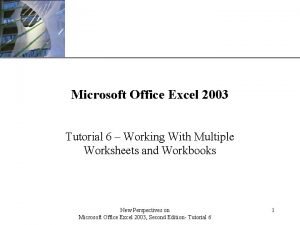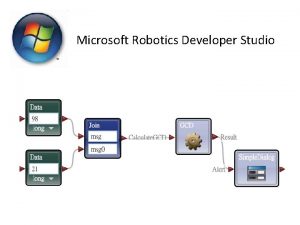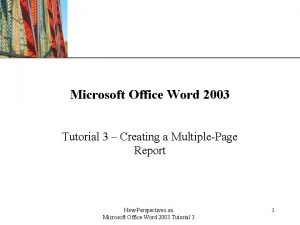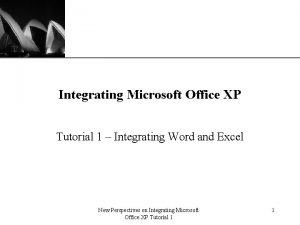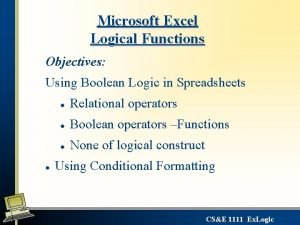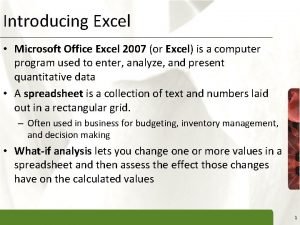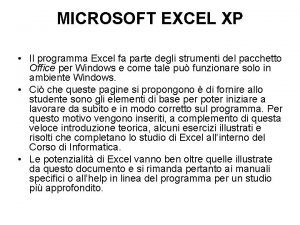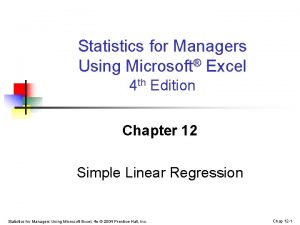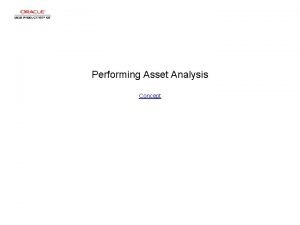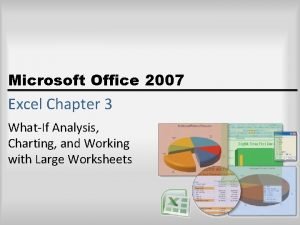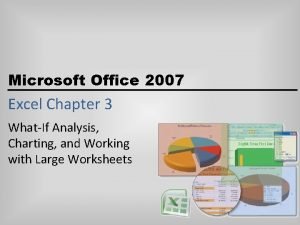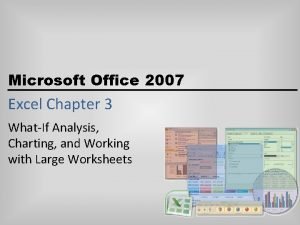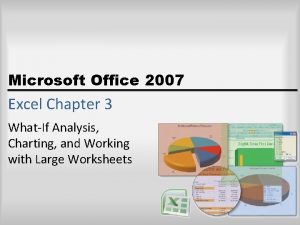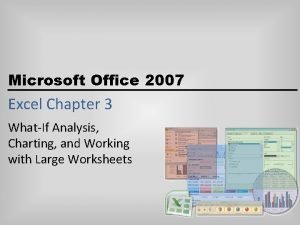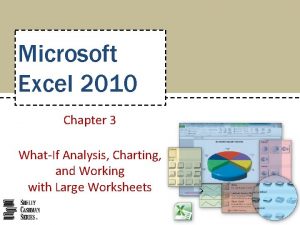Tutorial 10 Performing WhatIf Analyses Microsoft Excel 2013





















































- Slides: 53

Tutorial 10: Performing What-If Analyses Microsoft Excel 2013 ® ®

Objectives XP • Explore the principles of cost-volume-profit relationships • Create a one-variable data table • Create a two-variable data table • Create and apply different Excel scenarios with the Scenario Manager • Generate a scenario summary report New Perspectives on Microsoft Excel 2013 2

Objectives • • • XP Generate a scenario Pivot. Table report Explore the principles of a product mix Run Solver to calculate optimal solutions Create and apply constraints to a Solver model Save and load a Solver model New Perspectives on Microsoft Excel 2013 3

Visual Overview: XP Data Tables and What-If Analysis New Perspectives on Microsoft Excel 2013 4

Visual Overview: XP Data Tables and What-If Analysis New Perspectives on Microsoft Excel 2013 5

Understanding Cost-Volume Relationships XP • Cost-volume-profit (CVP) analysis – Studies the relationship between expenses, sales volume, and profitability – Helps predict the effect of cutting overhead or raising prices on a company’s net income New Perspectives on Microsoft Excel 2013 6

Understanding Cost-Volume Relationships XP • Comparing Expenses and Revenue – Types of expenses • Variable expenses change in proportion to the amount of business a company does • Fixed expense must be paid regardless of sales volume • Mixed expense is part variable and part fixed New Perspectives on Microsoft Excel 2013 7

Understanding Cost-Volume Relationships New Perspectives on Microsoft Excel 2013 XP 8

Understanding Cost-Volume Relationships XP • Exploring the Break-Even Point – The point where total revenue equals total expenses is called the break-even point • When sales are above the break-even point, a company profits • When sales are below the break even point, a company loses money – CVP analysis is sometimes called break-even analysis New Perspectives on Microsoft Excel 2013 9

Understanding Cost-Volume Relationships XP • Exploring the Break-Even Point (cont’t) – A CVP chart shows the relationship between total expenses and total revenue; the break-even point occurs where the two lines cross New Perspectives on Microsoft Excel 2013 10

Understanding Cost-Volume Relationships XP • Finding the Break-Even Point with What-if Analysis – Lets you explore the impact of changing different values in a worksheet – Can use to explore the impact of changing financial conditions on a company’s profitability – One way of finding the break-even point is to use Goal Seek, but a more efficient approach is to use a data table New Perspectives on Microsoft Excel 2013 11

Working with Data Tables XP • A data table is an Excel table that displays the results from several what-if analyses; the table consists of input cells and result cells – Input cells are the cells whose value would be changed in a what-if analysis – Result cells are cells whose values are impacted by the changing input values – You can use one-variable data tables and twovariable data tables New Perspectives on Microsoft Excel 2013 12

Working with Data Tables XP • Creating a One-Variable Data Table – Specify one input cell and any number of result cells – The range of possible values for the input cell is entered in the first row or column of the data table; the corresponding result values appear in the subsequent rows or columns – Useful in business to explore how changing a single input cell can impact several financial results New Perspectives on Microsoft Excel 2013 13

Working with Data Tables New Perspectives on Microsoft Excel 2013 XP 14

Working with Data Tables XP • Creating a One-Variable Data Table (con’t) – Identify the result value cell based on input values • The row input cell is used when the input values have been placed in the first row of the data table • The column input cell is used when the input values are placed in the data table’s first column New Perspectives on Microsoft Excel 2013 15

Working with Data Tables XP • Charting a One-Variable Data Table – Gives a better picture of relationship between sales volume, revenue, and total expenses New Perspectives on Microsoft Excel 2013 16

Working with Data Tables XP • Modifying a Data Table – Data tables are dynamic; changes in the worksheet are automatically reflected in the data table values – Includes changes to cells that are not part of the data table but are involved in the values displayed in the result cells New Perspectives on Microsoft Excel 2013 17

Working with Data Tables XP • Creating a Two-Variable Data Table – Lets you view the relationship between two input cells, but can display only a single result value – Analyzes a variety of combinations simultaneously New Perspectives on Microsoft Excel 2013 18

Working with Data Tables New Perspectives on Microsoft Excel 2013 XP 19

Working with Data Tables XP • Formatting the Result Cell – You can hide a cell value using the custom format “text”, where text is the text you want to display in place of the cell value New Perspectives on Microsoft Excel 2013 20

Working with Data Tables New Perspectives on Microsoft Excel 2013 XP 21

Working with Data Tables XP • Charting a Two-Variable Data Table – You can chart the values from a two-variable data table using lines to represent the different columns of the table New Perspectives on Microsoft Excel 2013 22

Visual Overview: What-If Scenarios New Perspectives on Microsoft Excel 2013 XP 23

Visual Overview: What-If Scenarios New Perspectives on Microsoft Excel 2013 XP 24

Developing Financial Scenarios with the Scenario Manager XP • Create scenarios to perform a what-if analysis with more than two input cells • A scenario is a defined set of values for different cells grouped under a common name New Perspectives on Microsoft Excel 2013 25

Developing Financial Scenarios with the Scenario Manager XP • Create scenarios using the Scenario Manager – Lets you define input values within a named scenario and quickly switch from one to the other – Can be used to create summary reports • Before using the Scenario Manager – Define names for all input and result cells that you intend to use in the analysis – Defined names automatically appear in reports generated by the Scenario Manager – Using defined names makes it easier to work with scenarios and understand the scenario reports New Perspectives on Microsoft Excel 2013 26

Developing Financial Scenarios with the Scenario Manager XP • Defining a Scenario – Each scenario includes a scenario name, input cells, and values for each input cell – Number of scenarios is limited only by computer’s memory – Input cells are referred to as “changing cells” • Contain values that are changed under the scenario • Can be located anywhere in the worksheet New Perspectives on Microsoft Excel 2013 27

Developing Financial Scenarios with the Scenario Manager New Perspectives on Microsoft Excel 2013 XP 28

Developing Financial Scenarios with the Scenario Manager New Perspectives on Microsoft Excel 2013 XP 29

Developing Financial Scenarios with the Scenario Manager XP • Viewing Scenarios – View the effect of each scenario by selecting it in the Scenario Manager dialog box – Switch from one scenario to another by clicking the Show button in the Scenario Manager dialog box – Excel automatically changes the values of the input cells to match the scenario New Perspectives on Microsoft Excel 2013 30

Developing Financial Scenarios with the Scenario Manager XP • Editing a Scenario – Edit the assumptions to view other possible outcomes – Worksheet calculations are automatically updated to reflect the new scenario New Perspectives on Microsoft Excel 2013 31

Creating a Scenario Summary Report XP • Create a report either as an Excel table or as an Excel Pivot. Table to compare the results from multiple scenarios on a single worksheet • To create a scenario summary report, you must identify which result cells you want to include in the report • The scenario summary report displays the values of the input cells and result cells under each scenario – Each scenario is listed by name – The current worksheet values are also displayed – The report used the defined names you created New Perspectives on Microsoft Excel 2013 32

Creating a Scenario Summary Report New Perspectives on Microsoft Excel 2013 XP 33

Creating a Scenario Summary Report XP • A Scenario Pivot. Table report displays results from each scenario as a Pivot. Table field in a Pivot. Table • Scenario Pivot. Table reports are created through the Scenario Manager used to create a summary report New Perspectives on Microsoft Excel 2013 34

Creating a Scenario Summary Report XP • You can edit the scenario Pivot. Table to make it easier to read • Results for a scenario Pivot. Table can be displayed in a Pivot. Chart New Perspectives on Microsoft Excel 2013 35

Visual Overview: Optimal Solutions with Solver New Perspectives on Microsoft Excel 2013 XP 36

Visual Overview: Optimal Solutions with Solver New Perspectives on Microsoft Excel 2013 XP 37

Introducing Product Mix XP • The combination of products offered by a company is known as the company’s product mix • Products differ in their sales price, production costs, and attractiveness to consumers • A company might find that it is more profitable to devote more of its resources to selling one product over another • Goal is to maximize profits while meeting the demands of the market • The optimal product mix is the product mix that will result in the most profit for the company New Perspectives on Microsoft Excel 2013 38

Introducing Product Mix New Perspectives on Microsoft Excel 2013 XP 39

Introducing Product Mix XP • Different product mixes result in lower or higher profit for the company • The best way to find the optimal product mix usually isn’t obvious; there are too many possible combinations • To find the one product mix that results in the maximum net profit for the company, you can use Solver New Perspectives on Microsoft Excel 2013 40

Finding an Optimal Solution Using Solver XP • Solver finds the numeric solution to a problem involving several input values • Solver can: – Be used to find the combination of input values that maximizes profits – Be used to find a set of input values that minimizes costs – Act like Goal Seek and find the input values required to match a given result New Perspectives on Microsoft Excel 2013 41

Finding an Optimal Solution Using Solver XP • Activating Solver – Solver is an add-in—a program that adds customized commands and features to Microsoft Office programs – Solver might need to be activated before you can use it New Perspectives on Microsoft Excel 2013 42

Finding an Optimal Solution Using Solver XP • Setting the Objective Cell and Variable Cells – Every Solver model needs an objective cell and one or more variable cells – An objective cell is a result cell that is maximized, minimized, or set to a specific value – A variable cell is an input cell that changes so that the objective cell can meet its defined goal New Perspectives on Microsoft Excel 2013 43

Finding an Optimal Solution Using Solver New Perspectives on Microsoft Excel 2013 XP 44

Finding an Optimal Solution Using Solver XP • Adding Constraints to Solver – Almost every Solver model needs one or more constraints – A constraint is a limit that is placed on the solution – Solver supports six types of constraints New Perspectives on Microsoft Excel 2013 45

Finding an Optimal Solution Using Solver New Perspectives on Microsoft Excel 2013 XP 46

Finding an Optimal Solution Using Solver New Perspectives on Microsoft Excel 2013 XP 47

Creating a Solver Answer Report XP • Solver can create three different reports – Answer report summarizes the results of a successful solution by displaying information about the objective cell, changing cells, and constraints – Sensitivity report and limits report are often used in science and engineering to investigate the mathematical aspects of the Solver solution; these reports allow you to quantify the reliability of the solution New Perspectives on Microsoft Excel 2013 48

Creating a Solver Answer Report New Perspectives on Microsoft Excel 2013 XP 49

Creating a Solver Answer Report XP • The answer report is divided into the following sections: – Title – Solver Engine – Solver Options – Objective Cell – Variable Cell – Constraints New Perspectives on Microsoft Excel 2013 50

Creating a Solver Answer Report XP • The status of each constraint is listed as either Binding or Not Binding – A binding constraint must be included in the Solver model and is a limiting factor in arriving at the solution – A nonbinding constraint does not need to be included as part of the Solver model • The Constraints section also shows the slack for each constraint; the slack is the difference between the value in the cell and the value at the limit of the constraint New Perspectives on Microsoft Excel 2013 51

Saving and Loading Solver Models. XP • You can apply several Solver models to the same data • You can store the Solver parameters for a model in worksheet cells that you can later retrieve and use to rerun that Solver model • By saving the Solver model parameters to cells on the worksheet, you can create as many models as you need to effectively analyze the data • You can then load and apply these different models to your analysis as new data is entered New Perspectives on Microsoft Excel 2013 52

Saving and Loading Solver Models. XP New Perspectives on Microsoft Excel 2013 53
 Tutorial access 2013
Tutorial access 2013 Uraikan tentang efektivitas rumus pada microsoft excel 2013
Uraikan tentang efektivitas rumus pada microsoft excel 2013 Microsoft official academic course microsoft excel 2016
Microsoft official academic course microsoft excel 2016 Microsoft excel merupakan program aplikasi?
Microsoft excel merupakan program aplikasi? Molecular ecological network analyses
Molecular ecological network analyses Critical thinking example in nursing
Critical thinking example in nursing Rhetorical essay
Rhetorical essay Icp courtage
Icp courtage Powerpivot 自習書
Powerpivot 自習書 Exploring microsoft office 2013 volume 1
Exploring microsoft office 2013 volume 1 Woven mat texture fill in excel
Woven mat texture fill in excel Microsoft access 2013
Microsoft access 2013 Clip art microsoft word 2013
Clip art microsoft word 2013 How to install solver in excel
How to install solver in excel Excel 2003 tutorial
Excel 2003 tutorial Microsoft office project tutorial
Microsoft office project tutorial Microsoft outlook 2010 tutorial
Microsoft outlook 2010 tutorial Forefront identity manager tutorial
Forefront identity manager tutorial Microsoft access 2003 tutorial
Microsoft access 2003 tutorial Tutorial project 2007
Tutorial project 2007 Project 2010 tutorial
Project 2010 tutorial Omada identity
Omada identity Microsoft robotics developer studio
Microsoft robotics developer studio Microsoft test manager tutorial
Microsoft test manager tutorial Microsoft word 2003 tutorial
Microsoft word 2003 tutorial Microsoft windows tutorial
Microsoft windows tutorial Microsoft project tutorial
Microsoft project tutorial Microsoft robotics developer studio tutorial
Microsoft robotics developer studio tutorial Microsoft access reports tutorial
Microsoft access reports tutorial Access tutorial 2010
Access tutorial 2010 Project 2007 tutorial
Project 2007 tutorial Word 2003 tutorial
Word 2003 tutorial Microsoft office xp tutorials
Microsoft office xp tutorials El software utilitario microsoft excel es:
El software utilitario microsoft excel es: Fasilitas di microsoft excel yang dimaksud adalah
Fasilitas di microsoft excel yang dimaksud adalah Pengenalan microsoft excel
Pengenalan microsoft excel Excel logical operators
Excel logical operators Ms excel vocabulary
Ms excel vocabulary Pengenalan microsoft word
Pengenalan microsoft word Mengoperasikan microsoft excel
Mengoperasikan microsoft excel Lembar kerja program aplikasi pengolah angka
Lembar kerja program aplikasi pengolah angka Microsoft excel xp
Microsoft excel xp Exploring microsoft office excel 2016 comprehensive
Exploring microsoft office excel 2016 comprehensive Microsoft excel 2016 basics vocabulary
Microsoft excel 2016 basics vocabulary Excel 2010 training
Excel 2010 training Que representa
Que representa Perintah untuk membuat grafik terdapat pada menu
Perintah untuk membuat grafik terdapat pada menu Zakadki
Zakadki Modul microsoft excel
Modul microsoft excel Sebutkan ikon yang ada pada menu bar ms excel
Sebutkan ikon yang ada pada menu bar ms excel Microsoft excel xp
Microsoft excel xp Bentuk operator perpotongan sel antara dua acuan
Bentuk operator perpotongan sel antara dua acuan Ikon microsoft excel
Ikon microsoft excel Durbin watson test in excel
Durbin watson test in excel














